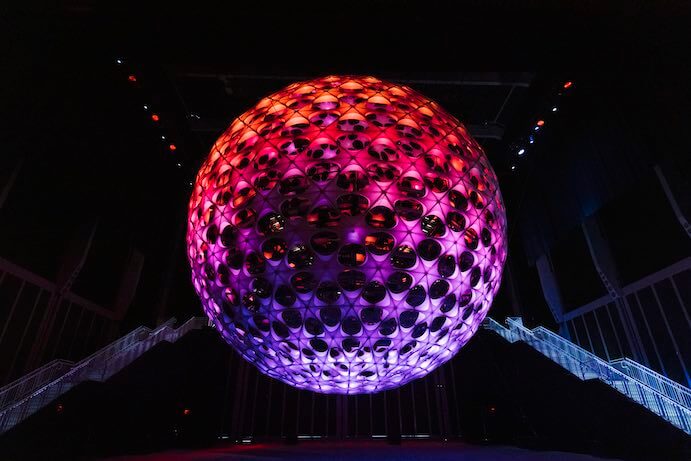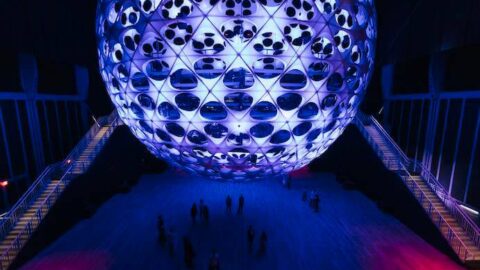I’m in the center of a dome. Fragmented vocalizations pop from somewhere in the space — it’s hard to pinpoint their origin — and the isolated sounds gradually swell into a cocooning melodic swirl. I feel enveloped by the sound, amused by the gentle dance of light on the wall, and comforted by the presence of other murmuring happy listeners.
I could be dreaming of the Kugelauditorium, the world’s first spherical concert hall, conceptualized by Karlheinz Stockhausen and realized at the 1970 World Expo in Osaka, where hundreds of thousands of visitors experienced three-dimensional sound emanating from the hall’s 50 loudspeakers. Built in collaboration with architectural and audio engineers, the Kugelauditorium was both a novel audiovisual experience and a new instrument for immersive experimentation.
But I could also be recalling Janet Cardiff’s The Forty Part Motet (2001) installation in the apse of Spain’s Fuentidueña Chapel, which is on a long-term loan to The Cloisters in uptown New York City. Cardiff arranged 40 speakers in a large oval inside the 12th-century apse, reworking Thomas Tallis’ 1573 motet Spem in Alium and inviting visitors to wander and experience the resonant space.
But I’m not in Osaka or Washington Heights. I’m in Hudson Yards, New York’s blue-glass enclave of skyscrapers sliced by the winding High Line public park, and I have climbed inside The Shed’s 65-foot-diameter spherical concert hall for a 9 p.m. Lab Session with composer Raquel Acevedo Klein. The Sonic Sphere is a concert venue that offers 3-D sound, complex lighting, 124 speakers arranged in Fibonacci configuration, and sensitive spatial control. Covered in neon lights and suspended in The Shed’s enormous McCourt space, entering the giant structure feels like a reenactment of Close Encounters of the Third Kind.

Acevedo Klein has arguably the best gig of all: free rein to tinker with the capabilities of the spherical hall/instrument. The Sonic Sphere is claimed to be driven by a spirit of empathy and experimentation; despite the media hype, the opportunity to experiment with such a large system is the most intriguing and especially useful application of the spherical concert space, from a compositional point of view.
Acevedo Klein took hold of the imposing sphere through a live improvisation with guitarist Asher Kurtz, and Polyphonic Interlace, a multilayered piece inspired by Spem in Alium made entirely of her own voice during lockdowns.
Polyphonic Interlace was premiered at Little Island’s inaugural festival; attendees downloaded a single voice part and played it on their phones while dispersed across the Manhattan public park. Acevedo Klein is adept at designing custom-made, democratized sonic experiences. Polyphonic Interlace had one spatialization demo at a sound studio in Brooklyn before the performance at The Shed. It would have benefitted from at least one test run in the Sonic Sphere. Although the surround sound was balanced — blended so well that the lack of power rendered it almost underwhelming — the text of Acevedo Klein’s recordings was strangely incomprehensible, and the compositional textures lacked depth. The performance paired percussive, pointillistic sound fragments with the dome’s blinking neon light pattern; later, in the most satisfying moment, it seemed like all 40 of the recorded parts surged into a warm halo of choral sound.

The second piece, with live vocal processing and Kurtz’s electric guitar curling throughout the space, was much more calibrated and effective. The audience reclined on reinforced, netted scaffolding as Kurtz and Acevedo Klein let single electric guitar notes and sparse, slow melodies overlap and decay with plenty of time to indulge a summer night’s vibe.
This real-time experimentation was the unique reward of the evening: the audience was invited not only to an immersive sonic experience, but also into the creative process. Acevedo Klein led an energetic discussion after her first piece, explicitly seeking feedback and boldly inviting the audience into her considerations for future iterations. This kind of session is a precious opportunity for artists and audiences alike — the kind of futuristic thinking we all need.
I CARE IF YOU LISTEN is an editorially-independent program of the American Composers Forum, and is made possible thanks to generous donor and institutional support. Opinions expressed are solely those of the author and may not represent the views of ICIYL or ACF.
You can support the work of ICIYL with a tax-deductible gift to ACF. For more on ACF, visit the “At ACF” section or composersforum.org.
























